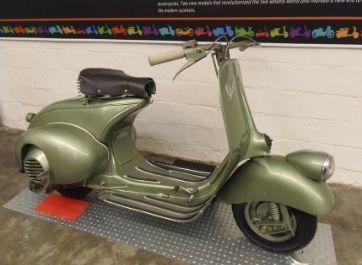This site uses cookies to provide you with a better experience. By clicking on "Accept" all categories of cookies will be activated. To decide which ones to accept, click on "Customize" instead. For more information you can consult the page *** Cookie policy.
Vespa 125, what is it and how does it work?
Posted on 23.07.2021Vespa 125: what? It is a myth of the two-wheeler produced by Piaggio. When reference is made to the Vespa, we mean a scooter model from Piaggio, patented on 23 April 1946, based on a design by the aeronautical engineer Corradino D'Ascanio. The Vespa has become one of the most famous industrial design products and has been exhibited in design, modern art, science & technology and transport museums all over the world. In addition to this, it has become part of the history of Italy and today it is celebrated all over the world. In addition to a history studded with great successes, various films and songs contributed to building the myth. Despite this, many - obviously leaving out the enthusiasts - do not know, even today what is referred to when we say Vespa 125. What does Vespa 125 mean? The number juxtaposed to cc indicates the displacement which is expressed in cubic centimeters. The motorcycles can have for example: 50, 125, 500, 650, 1100cc. How does a Vespa 125 work? What is its history and how many models of this beautiful and beloved two-wheeler have been produced?
Vespa 125, a bit of history, the first 125 models
Between 1957 and 1960 the basic model Vespa 125 makes its way. There are two series, namely VNA1T and VNA2T. Characteristics? Intake to the piston ported cylinder, with 5% mixture, handlebar in stamped sheet metal, divided in two. In the first production, up to frame 20220, the upper part is closed and it is not possible to mount the odometer. Subsequently, an odometer hole appears with a cap, because the odometer is not yet fitted as standard. No choke control in the tap area but continue with the lever under the saddle.The Vespa 1959 VNB was released between 1966 and 125. Six series that can be distinguished: VNB1T, VNB2T, VNB3T, VNB4T, VNB5T and VNB6T. Characteristics? The carburetor is placed on the crankcase and no longer on the cylinder. The mixture thus passes from 5% to 2% with numerous advantages. Which? First of all, greater fluidity and then less consumption. Costs are lowered for Vespa lovers and emissions and pollution are also lower.
We start talking about the "125 Nuova" thanks to the first Vespa smallframe with a standard 125cc engine. When? Between 1965 and 1967 about 17.100 copies were produced with a single color, namely metallic blue. This scooter has some fundamental features such as: the footboard strips that are wider, the fuel tap control that has an aluminum knob like the 50cc and the single-seat. Today this model is one of the most sought after by collectors.
Almost in the same years, between 1965 and 1969 the Vespa 125 Super comes out. It is a two-wheeler equipped with an engine and an improved carburetor. Thanks to them the vehicle can exceed 80 km / h. New fender, side bags, handlebar with a new odometer, but also the possibility to install mirrors and windshield. Other? The Vespa 125 Super also allows you to adjust the headlight with a screw.
In 1968 the Vespa 125 Primavera, on the other hand, had to replace the New 125. Features? Enhanced engine, despite unchanged cubic capacity at 121 cm and ignition always with points. Power from 4,8 HP at 4500 rpm reaches 5,56 at 5500 rpm. In this way the speed of the vehicle reaches 92,3 km / h with a much more lively acceleration. In 1976, however, the Vespa 125 ET3 Primavera was born in 1976 alongside a model already in production, the Vespa 125 Primavera. Characteristics? Surely the most important concerns the electronic ignition managed by the Ducati control unit.
Other Vespa 125 models? The following are included in the annals:
Vespa PK or the legitimate heir of the Vespa Primavera. It has been in production since 1982.
Vespa PK 125 Elestart. Here the electric starting system is powered by a battery.
Vespa PK 125 Automatica which is equipped with continuous variomatic transmission with automatic centrifugal clutch, and rear brake operated with the left lever.
Vespa PK 125 Elestart Automatica where both the automatic gearbox and the electronic starter are located.
Vespa PK 125 Plurimatic
Vespa P125 ETS. Produced between 1984 and 1986, it becomes the heir of the Primavera ET3.
Vespa 125 T5. Model produced from 1985 to 1989. Very similar to the base of the Vespa PX except for the rectangular headlight, the plastic fairing on the handlebar, the more vertical tail due to the larger instrumentation.
The Vespa PX 125
However, the Vespa PX deserves particular attention. This two-wheeled vehicle marked a great revolution at Piaggio. The reason? New bodywork, different handlebar bend, revised front fork with anti-sinking device. Characteristics that marked an important change of course and that led the Vespa to be more agile and responsive.It should be emphasized, however, that the first PXs did not have direction indicators, because they were not mandatory at that time. Only in 1980 the direction indicators will become standard as an accessory.
The Vespa PX remained substantially unchanged until the end of 1999. In that year the most important modification arrived. Which? The one that introduced the front disc brake. Thanks to the addition of the standard automatic mixer and the front halogen headlight, the legendary two-wheeler acquired reliability and safety.
Before the PX version was withdrawn from the market, Piaggio produced a limited edition of 1000 copies of the P125X in white livery and with an identification plate bearing the words "P125X Ultima Serie". In two weeks, the pieces were sold out.
Latest Headlines
- Discover the potential of the Stelvio 177 cylinder for your Vespa PX: a detailed guide Posted on 26.01.2024
- From the origins to the present day: The evolution of the Vespa 125 over the years Posted on 07.11.2023
- The disc brake kit: an essential upgrade for your Vespa 50 Special Posted on 18.10.2023
- How the Polini 130 cylinder can improve the performance of your Vespa Posted on 18.10.2023
- Buying guide for the Vespa 125 ET3: everything you need to know Posted on 17.10.2023
Search the Blog








